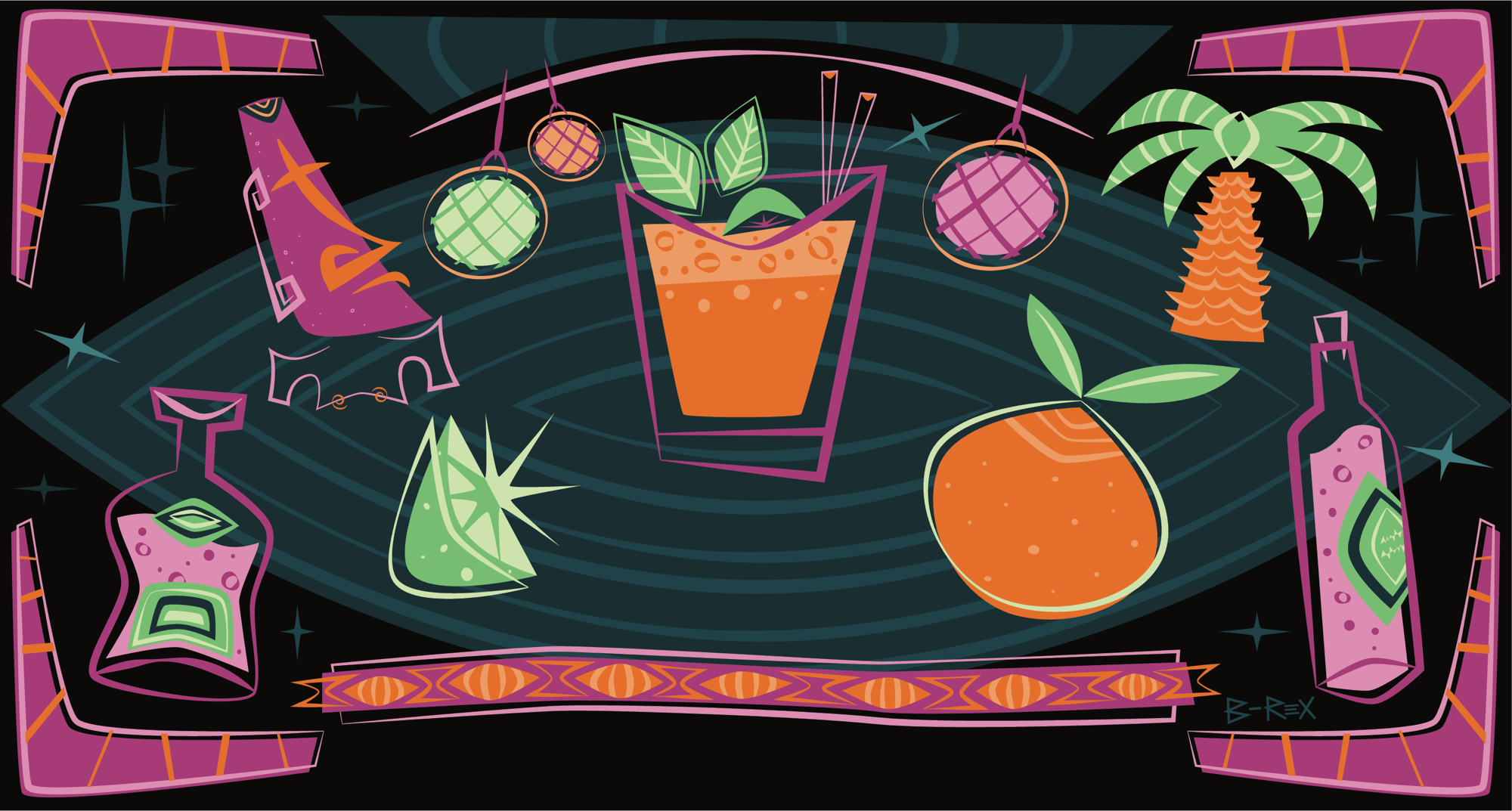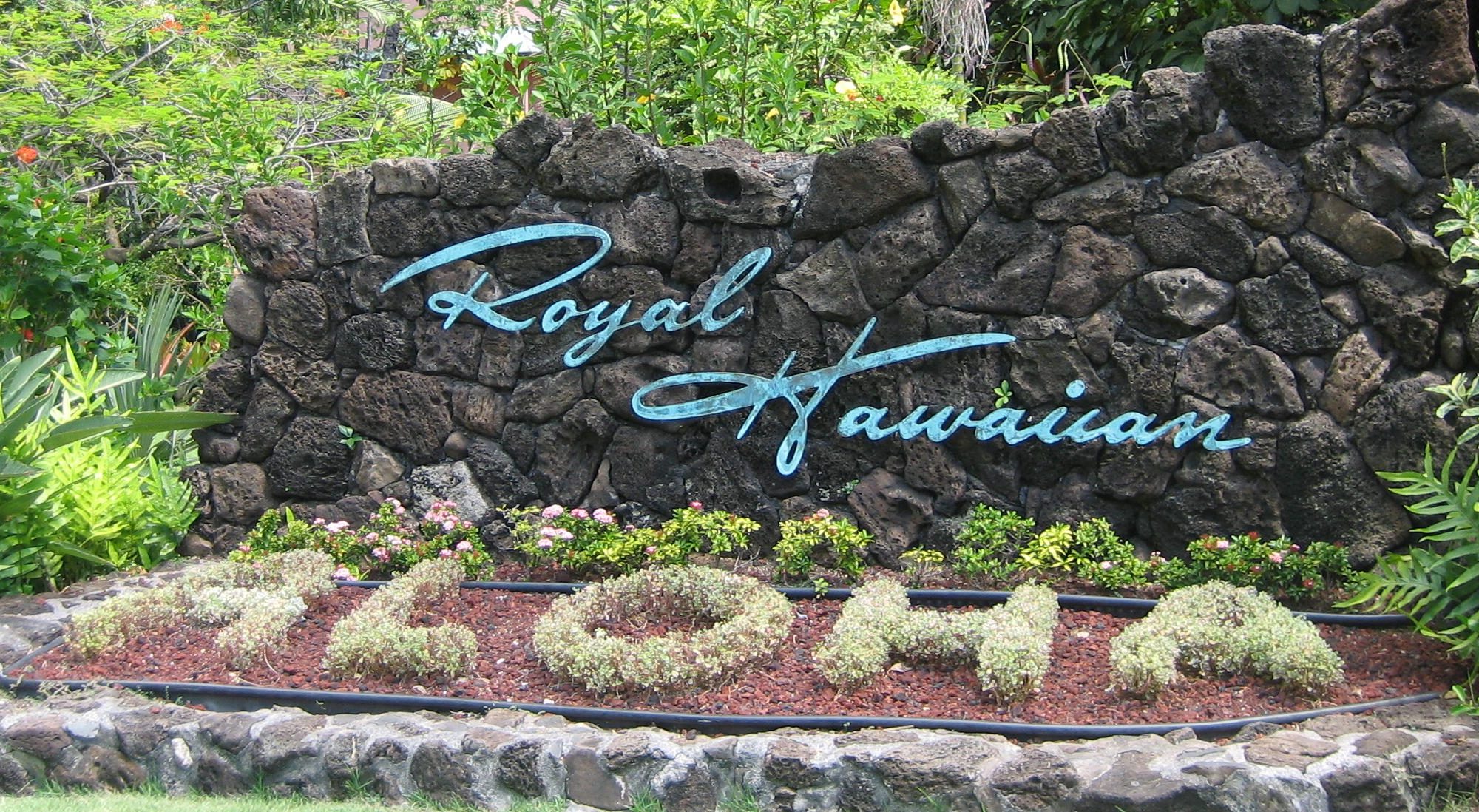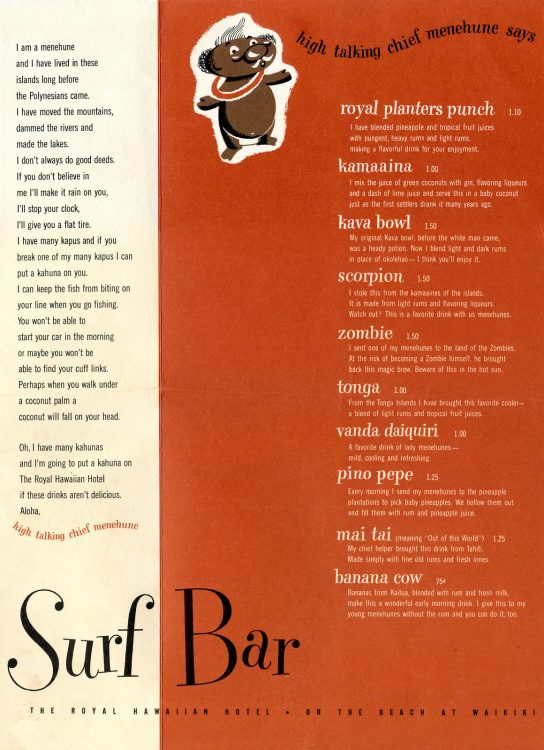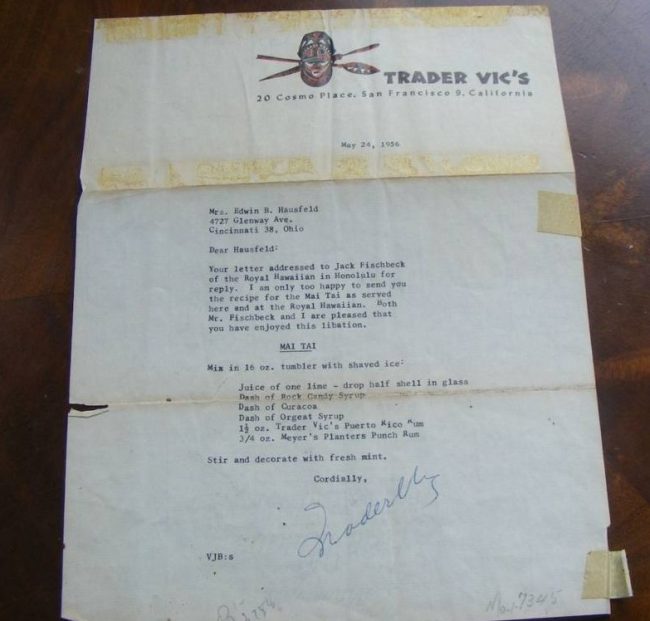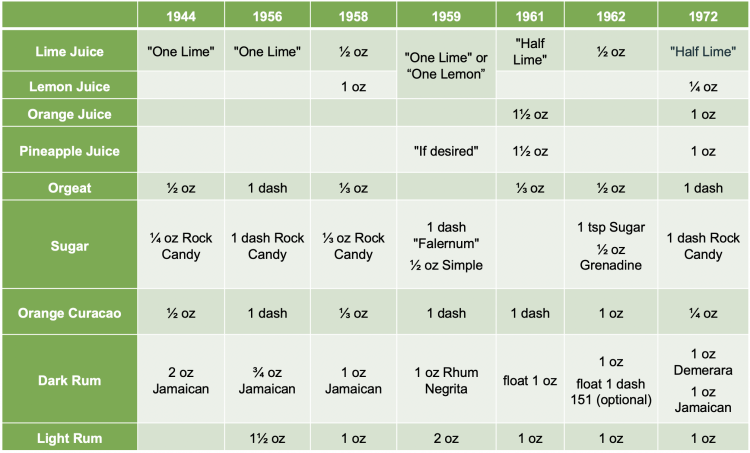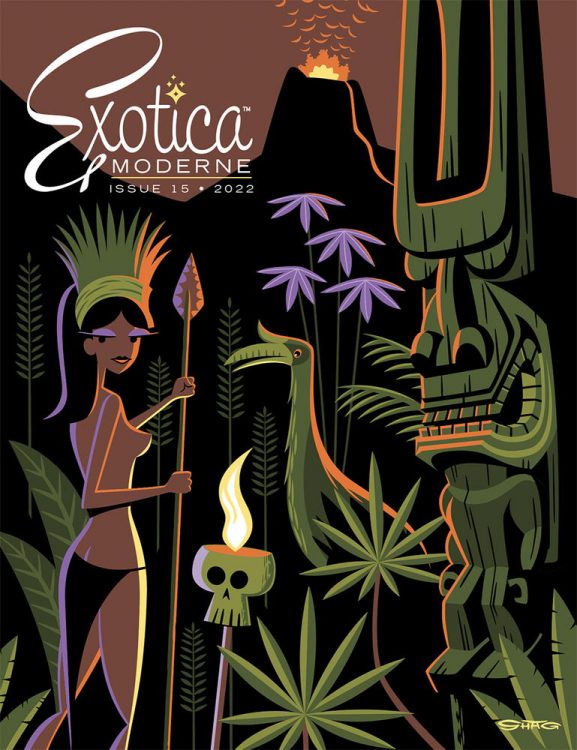By Kevin Crossman
A cocktail so iconic that the mere mention instantly conjures imagery of the islands. A cocktail instantly recognizable upon first gaze. A cocktail that everyone knows, but maybe doesn’t always respect. The Hawaiian Mai Tai.
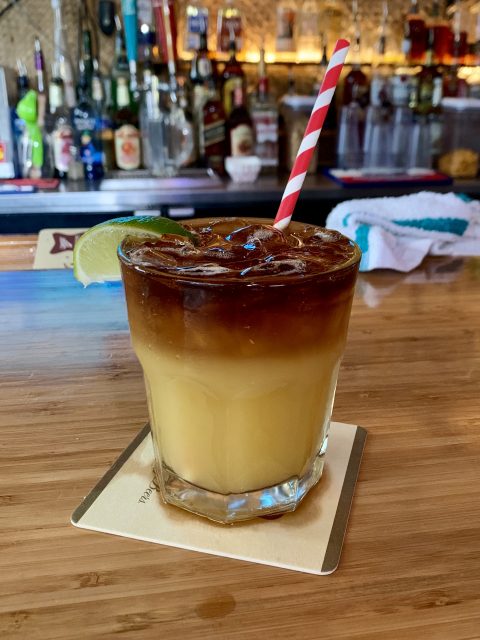
But when the Mai Tai was introduced to Hawai’i at the Royal Hawaiian Hotel and Moana Hotel in 1953, it wasn’t the world famous version with the pineapple juice and a dark rum float. It was Trader Vic Bergeron’s original 1944 Mai Tai recipe, or something very close to it. So how did we get from there to here? Contemporaneous reports and published recipes tell the story.
When the Mai Tai was created in 1944, it wasn’t an instant hit. While it does appear on the menu of Trader Vic’s Outrigger Restaurant in Seattle in 1948, it is buried in the middle of the cocktail list. So it was hardly a focus or a headliner. But Trader Vic must have believed in the drink because it was included in the list of cocktails he provided to the Matson Lines and their Waikiki hotel properties including the Royal Hawaiian and Moana. Moreover, Bergeron was quoted in February 1953 in the Honolulu Star-Bulletin 1 saying that of the newly introduced Royal Hawaiian cocktails the Mai Tai was his favorite. That quote also gives some perspective to Vic’s role in the “Mai Tai Origin Wars” and the great effort he went through to be known as the father of the cocktail. The Mai Tai appears to be his favorite child.
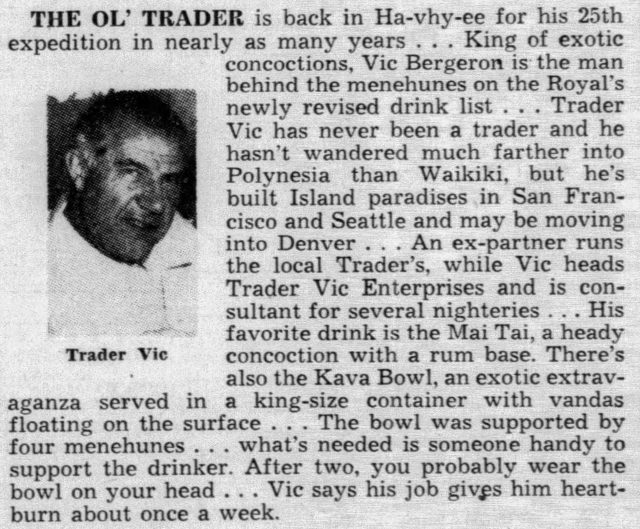
If you look at the menu of cocktails prepared by Bergeron, the Mai Tai is next to last at the bottom, and notably only mentions lime juice. Meanwhile, the top-listed Royal Planters Punch seems to have been the expected star, featuring bold rums and pineapple juice. Likely not so different than the Hawaiian Mai Tai we’ve come to know and love, minus orgeat and an exotic Tahitian name. Alas, the Royal Planters Punch was not a hit.
What was the recipe of this Royal Hawaiian Mai Tai? Bergeron himself provided a recipe to a past customer upon request in 1956, and the letter was later photographed when it went to auction in the early 2000s. The “1956 Mai Tai” is similar to the original 1944 Mai Tai recipe, but seems to be adjusted to ease production, lower costs, and to be somewhat more palatable to tourists.
1956 Mai Tai
Juice of One Lime – drop half lime shell in glass
Dash of Rock Candy Syrup
Dash of Curacao
Dash of Orgeat
1½ oz Trader Vic’s Puerto Rican Rum
¾ oz Myers’s Plantation Punch Rum
Stir and decorate with fresh mint
Note: A “Dash” when referring to these ingredients is equal to ¼ ounce, according to the 1972 Trader Vic’s Bartender’s Guide Revised.
The inclusion of a lighter Puerto Rican rum and the widely available Myers’s Jamaican rum means that the Royal Hawaiian would not need to be continually chasing availability of long aged Jamaican rums that had been the featured spirit in the Mai Tai up to that point. The use of Myers’s 97 proof Plantation Punch Rum adds rich flavor, and even in this proportion is quite forward in the finished cocktail. The light rum + dark rum combo is consistent across all Hawaiian Mai Tai recipes we’ve uncovered.
I also found this version of the recipe published in a Star-Bulletin gossip column 2 in 1968 attributed to the Moana Hotel sister property, likely indicating that this recipe remained active at the Royal Hawaiian for the following decade.
In 1958, a syndicated news story 3 published in newspapers nationwide provided a similar recipe that was attributed as coming from a bartender at the Royal Hawaiian.
1958 Mai Tai
1 oz Lemon Juice
½ oz Fresh Lime Juice
⅓ oz Rock Candy Syrup
⅓ oz Orgeat
⅓ oz Orange Curacao
1 oz Light Puerto Rican Rum
1 oz Dark Jamaican Rum
Decorate the glass with a stalk of Sugar Cane, a sprig or two of Mint, and a Pineapple stick or two.
This one is quite close to the 1956 version, except there are higher proportions of juice and sweeteners. The ⅓ ounce measures for the Rock Candy, Orgeat, and Orange Curacao are most likely due to those ingredients being batched so that the bartender can more easily measure 1 ounce of sweetener. This version uses basically the same two rums as the 1956 recipe.
By the late 1950s, the Mai Tai’s reputation was building and for tourists it seemed to be considered the signature vacation cocktail of the islands. A 1959 column from “Les Dine” in the Star-Bulletin 4 declared the Mai Tai the “Top Tourist Tantalizer,” supplanting the Zombie. An unattributed recipe was included in the article which said that these ingredients would require an investment of $35 to $40 to acquire.
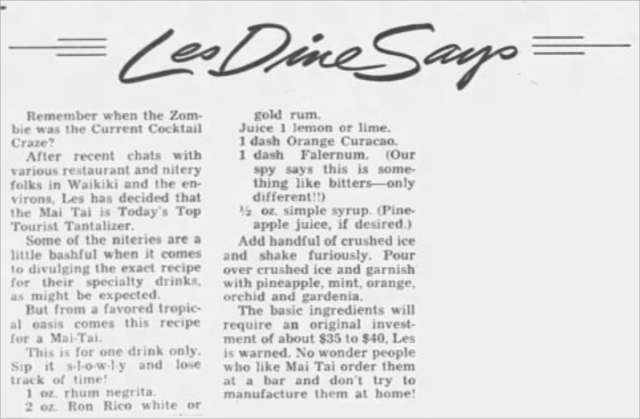
1959 Mai Tai
Juice of 1 Lemon or Lime
1 dash Orange Curacao
1 dash Falernum (“Our spy says this is something like bitters – only different!!”)
½ oz Simple Syrup
1 oz Rhum Negrita
2 oz Ron Rico white or gold rum
Pineapple juice, if desired.
Shake with a handful of crushed ice. Garnish with Pineapple, Mint, Orange, Orchid, and Gardenia.
Still quite similar, assuming that the spy confused Orgeat for Falernum. This version seems quite a bit more boozy, though. Perhaps the high volume of alcohol is what necessitated the inclusion of pineapple juice as a “desired addition” simply to keep the balance. Rhum Negrita was a dark French rum distilled from molasses and seems to serve as the flavor backbone, similar to how Jamaican rum was used in the earlier Hawaiian recipes.
The Original Hawaiian Mai Tai Lived On
From what we can see in these recipes so far, the Mai Tai started to be recognized as the most famous cocktail from the area, and yet remained substantially similar to the original 1944 recipe. This recipe continued remain popular through the 1960s and beyond.
Stan Deleplane published this Mai Tai recipe in his widely syndicated column in 1961. It is the same recipe that was published by Puerto Rican rum producer Ron Rico in a print ad the following year. The Ron Rico Mai Tai used a light rum alongside Myers’s Jamaica rum.
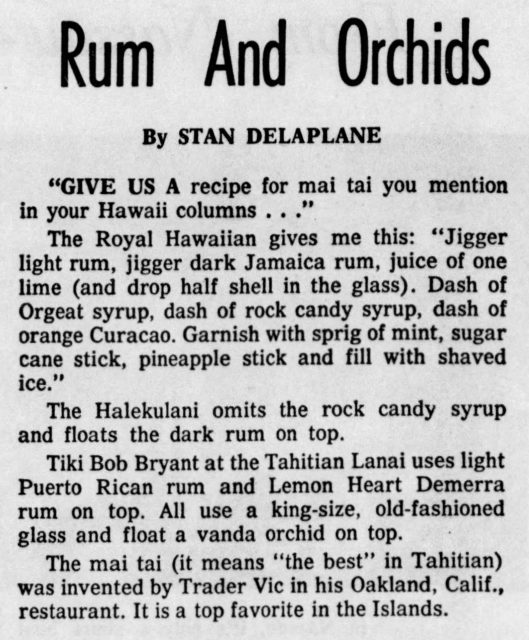
The 1950s-era Hawaiian Mai Tai remains available in some places to this very day, including the Halekulani Hotel. But things would change in a big way starting in the 1960s.
The 1960s Usher In the Age of Experimentation
The 1960s were the decade when pineapple juice became standard in most Mai Tais served in Hawai’i and beyond. It is also when the rum float started to become more frequently seen. An early forerunner of the devolved Mai Tai was printed in the Star-Bulletin5, attributed to Harry Loui who was the proprietor of the Kalia Gardens nightclub. A similar recipe also using Orange Juice but not floating the dark rum was also published in the Star-Bulletin 6 in 1961. If we’re looking for the birth of iconic Hawaiian Mai Tai, this one is quite representative of the Mai Tai that would become common in the decades to come.
1961 Mai Tai by Harry Loui
1½ oz Orange Juice
1½ oz Pineapple Juice
Juice of half a fresh Lime
⅓ oz Orgeat
Dash Orange Curacao
1 oz Light Rum
Stir with crushed ice and then add a float of 1 ounce of Dark Rum
Garnish with pineapple spear and orchid
A 1962 Star-Bulletin column called “Dining Out with the Gourmet” 7 revealed another devolved recipe by including Grenadine. The article again referenced the Mai Tai’s dominance over the Zombie, but acknowledged there were “endless variations” of the cocktail.
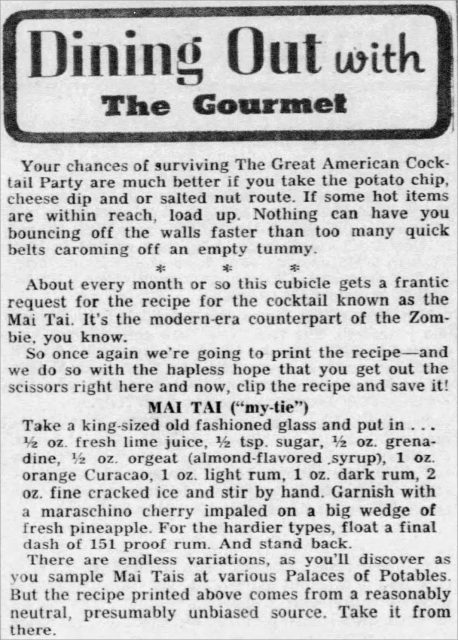
1962 Mai Tai
½ oz Fresh Lime Juice
½ tsp Sugar
½ oz Grenadine
½ oz Orgeat
1 oz Orange Curacao
1 oz Light Rum
1 oz Dark Rum
Garnish with Pineapple and Cherry
“For the hardier types, float a final dash of 151 proof rum. And stand back.”
The Royal Hawaiian Gives In
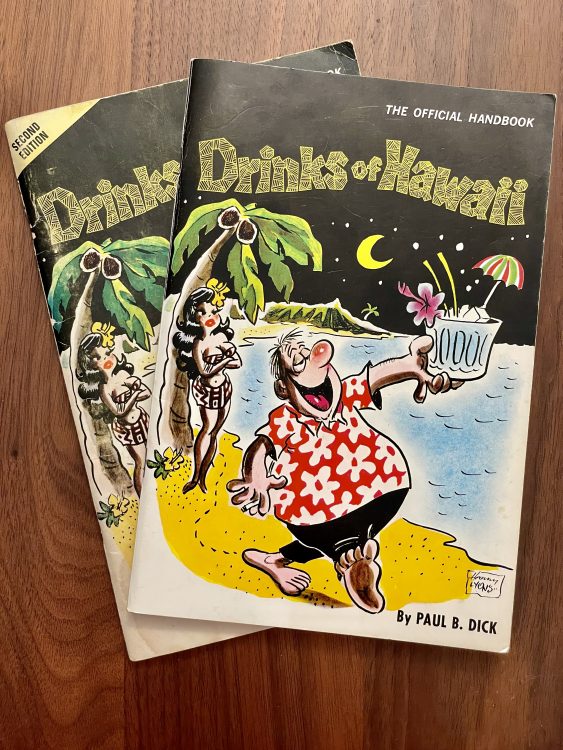 By the end of the 1960s, these pineapple-infused Mai Tais must have commonplace, though we continue to see published recipes in the 1970s and 1980s that omit it in lieu of the ingredient lists seen in the mid-1950s. The pineapple-forward Hawaiian Mai Tai certainly seems like the kind of cocktail that tourists would associate with Hawai’i, so there must have been considerable pressure from customers to receive this style of the cocktail. The Moana Hotel made a big splash in 1986 8 when they reintroduced the “original Mai Tai” without pineapple juice, bringing the venue back to the original 1953 specs. That trend was short-lived however and ended decades ago; today the Moana serves the Mai Tai with pineapple and a dark rum float.
By the end of the 1960s, these pineapple-infused Mai Tais must have commonplace, though we continue to see published recipes in the 1970s and 1980s that omit it in lieu of the ingredient lists seen in the mid-1950s. The pineapple-forward Hawaiian Mai Tai certainly seems like the kind of cocktail that tourists would associate with Hawai’i, so there must have been considerable pressure from customers to receive this style of the cocktail. The Moana Hotel made a big splash in 1986 8 when they reintroduced the “original Mai Tai” without pineapple juice, bringing the venue back to the original 1953 specs. That trend was short-lived however and ended decades ago; today the Moana serves the Mai Tai with pineapple and a dark rum float.
The Royal Hawaiian Hotel eventually caved and got into the act themselves by adding pineapple juice and orange juice by 1972, according to this recipe originally published 9 in Drinks of Hawaii (2nd edition) by Paul K. Dick. The book’s 3rd edition in 1975 included this recipe as well. This book is the holy grail of the classic Royal Hawaiian Mai Tai recipe. This recipe was subsequently picked up by Jeff “Beachbum” Berry who included it in his book Beachbum Berry Remixed.
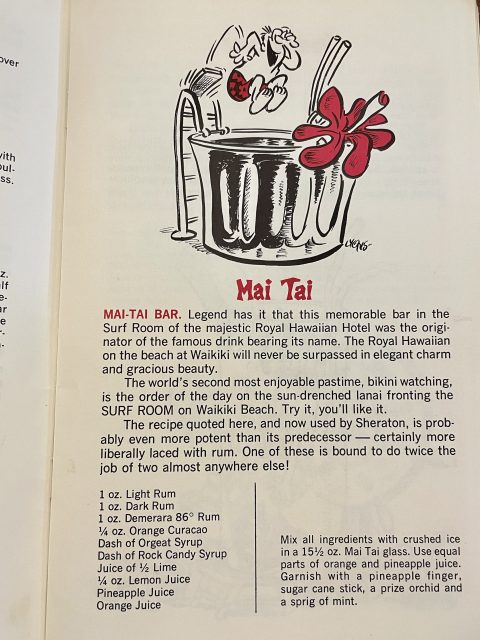
The recipe doesn’t specify exactly how much Pineapple and Orange Juice should be used, but Jeff “Beachbum” Berry suggested 1 oz each when he reprinted the recipe. While I suspect more probably would have been used, I do think 1 oz each is plenty considering that there is also Lime and Lemon Juice as well. The smaller portions of sugars and Curacao would also dictate a smaller than larger amount of juice.
1972 Royal Hawaiian Surf Room Mai Tai
1 oz Orange Juice
1 oz Pineapple Juice
½ oz Fresh Lime Juice
¼ oz Fresh Lemon Juice
¼ oz Orgeat
¼ oz Sugar Syrup
¼ oz Orange Curacao
1 oz Demerara Rum
1 oz Dark Jamaican Rum
1 oz Light Rum
Shake with ice and garnish with a pineapple finger, sugar cane stick, orchid, and mint sprig
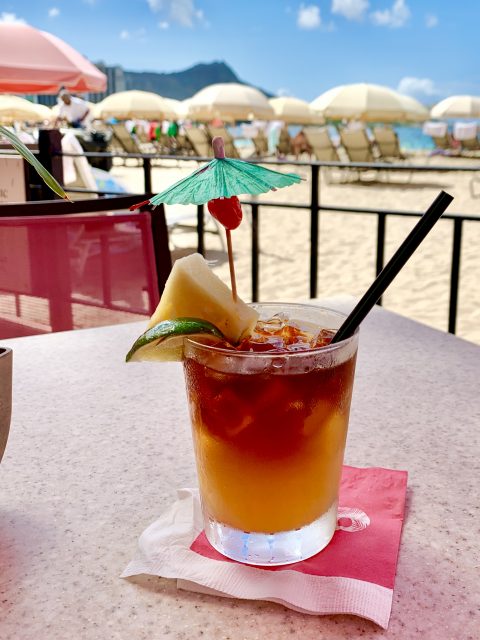
Today, the venue’s Royal Hawaiian Mai Tai remains in this typical Hawaiian style, though thankfully they’ve moved on from the use of Cherry Vanilla Puree and Amaretto used in years past.
50,000,000 Mai Tai Fans Can’t Be Wrong
The world famous Hawaiian Mai Tai as we know it today may not scratch the itch for most craft cocktail aficionados, but you don’t hear from many tourists complaining about the terrible Mai Tais they had in Hawai’i. When the rums used are of reasonable quality and when the pineapple juice is used as an accent rather than 50% of the base, it is easy to see why the cocktail is so popular. The look of the cocktail is iconic, and so is the taste. They go down easy, which is what most people want on vacation anyway.
Long live the Hawaiian Mai Tai.
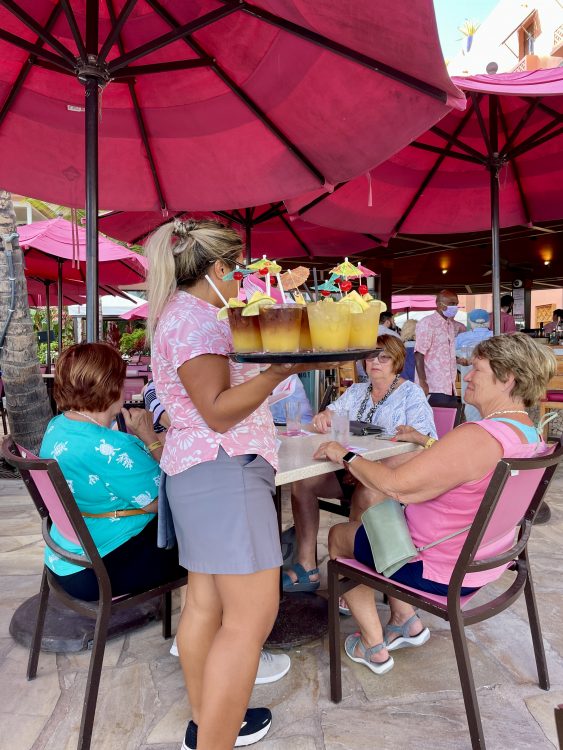
The (De)Evolution of the Hawaiian Mai Tai
References
- Honolulu Star-Bulletin, February 4, 1953, page 30
- Honolulu Star-Bulletin, October 9, 1968, page 47
- The Commercial Appeal (Memphis, Tennessee), June 15, 1958, page 84
- Honolulu Star-Bulletin, February 7, 1959, page 38
- Honolulu Star-Bulletin, April 23, 1961, page 62
- Honolulu Star-Bulletin, May 14, 1961, page 61
- Honolulu Star-Bulletin, January 28, 1962, page 56
- The Honolulu Advertiser, June 30, 1986, page 9
- Drinks of Hawaii (2nd Edition), by Paul K. Dick, Diamond Head Printers, 1972
This article originally appeared in Exotica Moderne, issue 15, 2022.
Tiki Kon Seminar: The (De)Evolution of the Hawaiian Mai Tai
Recorded July 1, 2022 at Tiki Kon, we’ve combined the professionally recorded audio with the slides so that you can experience it at home.
Everyone is familiar with the iconic Hawaiian Mai Tai that features pineapple juice and a dark rum float. This version of the Mai Tai is quite different from the original 1944 Mai Tai created at Trader Vic’s. When did the Mai Tai in Hawaii become the “Hawaiian Mai Tai?” It wasn’t in 1953 when Trader Vic brought the Mai Tai to Hawaii and is later than you might think. Learn more about this iconic cocktail and how it evolved over the years based on contemporaneous reports and published recipes.
Note that this presentation was updated for Mai Tai Day 2022 at Trader Vic’s. That presentation wasn’t recorded but you can view the slides on this site.
The Story of the Mai Tai Recipe that Made it Famous
Mid-2023 video with Derek from the Make & Drink channel on YouTube.
Can the Mai Tai Continue to Evolve?
That was the question posed by our friend Tiki with Ray in September 2022.
